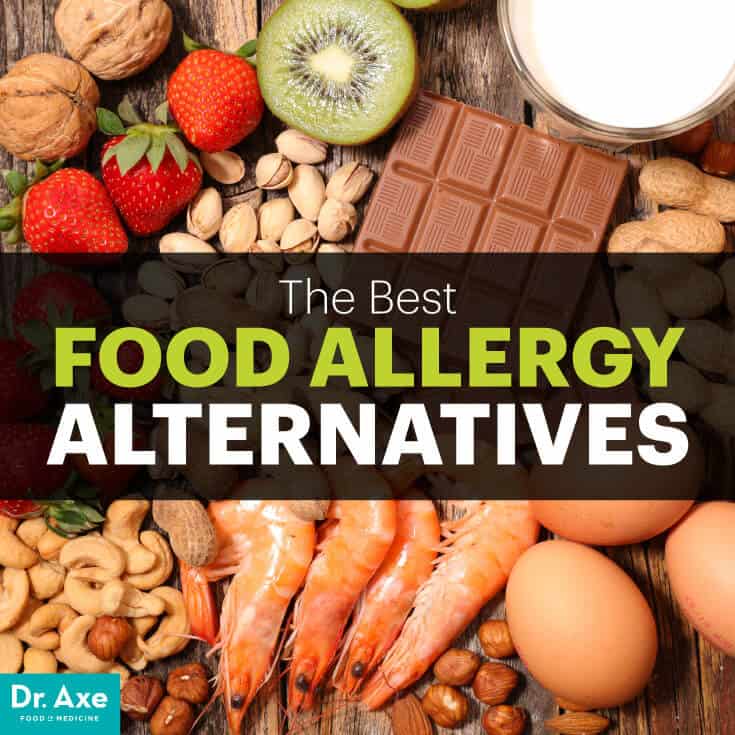
The prevalence of food allergies continue to rise, affecting approximately 5 percent of children under the age of 5 years old and 4 percent of teens and adults. Food allergies have severe effects on daily life because manifestations can affect several bodily systems, and these responses are caused by a particular individual intolerance that’s derived from an immunological mechanism. (1) This leads people to look for food allergy alternatives, but it’s not always easy.
Why? Because eight popular foods are responsible for more than 90 percent of food allergies, and the scary thing is that all food allergies have the potential to induce anaphylaxis, a life-threatening reaction. The only true treatment for a food allergy is to avoid the allergen altogether, which can be difficult when you’re allergic to commonly consumed foods like milk, eggs and wheat. Luckily, we have so many food allergy alternatives on the market that we can get the same nutritional value from.
What Are the Most Common Food Allergies?
Milk
Cow’s milk protein allergy affects 2 percent to 7.5 percent of children, while persistence in adulthood is uncommon since a tolerance develops in 51 percent of cases within two years and 80 percent of cases within two to three years. A milk allergy is an immunological reaction to one or more milk proteins. To treat the allergy, you have to avoid consuming milk and dairy products altogether. (2)
Eggs
Eggs are a versatile ingredient used in a wide range of manufactured food products, so avoiding eggs can be challenging. For people with an egg allergy, it’s important that they understand the potential for accidental exposure through cross-contamination. This can occur wherever food is being prepared or served, including at restaurants and bakeries. In addition, egg whites and shells are used as clarifying agents and can be found in soup sticks, wine, alcohol-based beverages and coffee drinks. Egg whites are also used as a wash for bread products. (3)
Peanuts
With the prevalence of peanut allergies rising in the United States, peanut products have been banned from many school lunchrooms and children’s parties. In the U.S., approximately 1 percent to 2 percent of the population has a peanut allergy, and the percentage continues to rise.
While the word “nut” is in the name, peanuts are actually legumes because they grow underground, as opposed to tree nuts. For this reason, people can be allergic to peanuts but not tree nuts and vice versa. Peanut allergies tend to be present early in life, and affected individuals generally don’t outgrow them. In highly allergic people, just trace quantities can induce allergic reactions, and in more than 70 percent of children with peanut allergies, symptoms develop at their first known exposure. (4)
Tree Nuts
Tree nuts are some of the most common foods that cause allergic reactions, and nearly all tree nuts have been associated with fatal allergic reactions. People living in the U.S. are commonly allergic to walnuts and cashews but could also have adverse reactions to Brazil nuts, hazelnuts, almonds, pecans, pistachios and more. (5)
Wheat
Wheat is one of the main food allergies, and it can be difficult because wheat is found in many foods, including ketchup, soy sauce and beer. There are even non-food items that contain wheat, such as some cosmetics and bath products.
A wheat allergy is sometimes confused with celiac disease, but these are different conditions. Those who have a wheat allergy experience a reaction that’s caused by antibodies. People with celiac disease react to gluten, a particular protein in wheat, and this causes an abnormal immune system reaction. (6)
Fish and Shellfish
Finned fish allergies and shellfish allergies are different, and someone can be allergic to one type of fish but not the other. Fish allergies often develop early in life, while a shellfish allergy tends to develop later, from adolescence onward. The approximate prevalence of fish and shellfish allergies is 0.5 percent to 5 percent. Strict avoidance of these allergens is the current standard of clinical care for those who are allergic. (7)
Soybeans
In recent years, the impact of soy foods and supplements upon human health has become increasingly controversial. There is conflicting evidence about the health risks and benefits of soybeans. One thing that’s clear is researchers are certain that soy allergies are becoming more common, affecting approximately 0.4 percent of children. It’s generally thought that the majority of children with a soy allergy develop tolerance in early childhood, but more research is needed to be sure of that. (8)

The Best 7 Food Allergy Alternatives
1. Coconut Milk
There are a number of commercially produced cow’s milk alternatives made from soy, coconut, rice, potato, oats, almonds, hazelnuts, cashews, hemp, flax, sunflower and macadamia nuts. These alternatives are not actually milk but extracts derived from plant sources, such as nuts, seeds and grains. Just as cow’s milk is fortified with nutrients like vitamin D and vitamin A, so are many of these milk alternatives. Some milk alternatives have a similar nutritional profile to that of cow’s milk, but others lack in certain areas.
Aside from the fact that soy allergies are also rising in the United States, I don’t recommend that you use it as a milk alternative because soy can be bad for you. The main issues with soy are that most of it contains phytoestrogens or estrogen mimickers in the body, and today soy is genetically modified. Genetically modified foods are linked to many health problems because they kill off good bacteria in the gut and damage digestive function. (9)
The best alternative for cow’s milk is coconut milk, a liquid naturally found inside of mature coconuts, stored within coconut “meat.” When you blend and then strain coconut meat, it becomes a thicker, coconut milk-like liquid. Coconut milk is completely free from dairy, lactose, soy, nuts and grains, so it’s a great option for anyone with dairy, soy or nut allergies along with lactose intolerance.
One concern about using coconut milk as a substitute for cow’s milk is the fat content and impact it can have on cholesterol levels. However, a 2013 study published in the Journal of Nutrition and Metabolism found that coconut milk actually improves cholesterol levels. After 60 healthy participants ate coconut milk porridge for five days of the week for eight weeks, their LDL levels decreased and HDL levels rose significantly. (10)
Cow’s milk contains more protein and calcium than coconut milk, but you can make up for it with foods. Include calcium-rich foods (like cooked kale, broccoli, watercress and bok choy) in your diet to make sure you get the nutrients you need. The best kind of coconut milk is organic and contains no added sugar, artificial sweeteners and preservatives. Look at the list of ingredients and make sure that it’s 100 percent coconut milk (coconut water is OK too); you want to avoid sugar additives.
2. Egg Substitutes
Eggs are often used as a binding or leavening agent in recipes, but there are some alternatives that can work just as well. The following egg substitutes are recommended by the Food Allergy and Anaphylaxis Network as great food allergy alternatives for eggs:
- For binding
- 2 tablespoons of fruit puree (such as mashed bananas and apple sauce)
- 1 tablespoon of ground flaxseeds with 3 tablespoons of water
- For leavening and binding
- 1.5 tablespoons of water, 1.5 tablespoons of oil and 1 teaspoon of baking powder
- 1 teaspoon of baking powder, 1 tablespoon of water and 1 tablespoon of vinegar
- 1 packet of gelatin and 2 tablespoons of warm water (mix when ready to use)
- 1 teaspoon of yeast dissolved in 1/4 cup of water (11)
There is also a potato-based commercial egg substitute from Ener-G Foods on the market. When mixed with water, this egg alternative mimics eggs in baked goods like cookies, muffins and cakes, making it a potentially helpful food allergy alternative.
3. Almond and Sunflower Seed Butter
The easiest and most common peanut butter alternative is almond butter. Almond butter is simply ground almonds, and there are many vital health benefits of almonds nutrition. Almonds are low in saturated fatty acids, rich in unsaturated fatty acids, and contain filling fiber, unique and protective phytosterol antioxidants, vitamins like riboflavin and trace minerals, such as magnesium.
Sunflower seed butter is also a great substitute for peanut butter that contains healthy fats and proteins. Plus, sunflower seed butter is free of tree nuts too, which is another common food allergy, making it a one of the most versatile food allergy alternatives. In fact, research shows that sunflower seed butter is an uncommon allergy. (12)
It provides plenty of protein and is loaded with vitamin E and magnesium. It also contains a good amount of omega-6 fatty acids. Because most people have way too many omega-6s in their diets and not enough omega-3s, don’t go overboard with sunflower seed butter (just have enough to enjoy the taste), and balance out the omegas by consuming omega-3 foods like chia seeds, fish oil, flaxseeds and hemp seeds.
4. Flaxseeds, Chia Seeds, Pumpkin Seeds and Sunflower Seeds
Nuts are a great snack because they’re high in omega-3 fatty acids and help control inflammation, boost brain function and improve cardiovascular health. The best food allergy alternatives for tree nuts are other foods that are high in 0mega-3s — this way you get the just about the same nutritional benefits.
Seeds make for a great snack packed with nutritional value. Try flaxseeds, chia seeds, pumpkin seeds and sunflower seeds. Research published in Current Allergy and Asthma Reports suggests that there is an association of peanut allergy with allergies to legumes, tree nuts, seeds, fruits and pollen. (13) Because of this common cross-reactivity, check with your allergist before using seeds as a nut alternative just to be safe.
5. Gluten-Free Flours/Grains
There are many flours that don’t contain wheat and can easily be used as an alternative in baking. Wheat-free and gluten-free flours include coconut flour, almond flour, spelt flour, oat flour and rice flour. Coconut flour is high in fiber and healthy fats. Its easily used by the body for energy and helps support a healthy metabolism while balancing blood sugar levels. A study published in the British Journal of Nutrition found that the glycemic index of coconut flour-supplemented foods decreased with increasing levels of coconut flour, which is probably due to its high dietary fiber content. (14)
Another great option is finely ground almond meal flour, which is packed with L-arginine, magnesium, copper, manganese, calcium and potassium. Almond flour works well in recipes for baked goods, and it even has cholesterol-lowering effects. (15)
There are also food allergy alternatives for wheat pasta and bread. There are brown rice and quinoa pastas on the market today, which have very similar textures and tastes to wheat pasta, especially if you use them with sauce. Gluten-free breads contain a combination of buckwheat, chickpeas, millet, potato, rice and tapioca flour — all safe food allergy alternatives for someone with a wheat allergy.
6. Protein Foods
Eating finned fish and shellfish is beneficial because they’re good sources of protein and omega-3 fatty acids. Protein is used in every single cell of the body and is critical for building muscle mass, helping balance hormones naturally and supporting neurological function. If you’re allergic to fish, you can get your daily dose of protein from eggs, raw dairy (like yogurt and kefir), grass-fed meat and organic poultry. If you follow a vegetarian or vegan diet, plant-based protein foods include lentils, black beans and natto.
Although wild-caught fish is an excellent way to consume omega-3 fatty acids, there are a number of other foods that can give you similar health benefits. Walnuts are an excellent source of these healthy fats, as are flaxseeds and chia seeds. Chia seeds, for example, are composed of protein, fats, carbohydrates, high dietary fiber, vitamins and minerals. They contain a high amount of antioxidants and support the heart and digestive system. There are plenty of chia seed recipes that provide many of the health benefits that you may be missing because of a fish allergy. (16)
7. Lentils and Quinoa
Soybeans are typically eaten by people who follow vegetarian or vegan diets and use soy as their source of protein or as a meat alternative. Three easy ways to get protein from meat-free foods are consuming legumes (such as lentils), beans and grains (such as quinoa). Lentils are high in protein, rich in nutrients and have a hearty, dense texture. Quinoa is one of the healthiest grains on the market; it’s hardy and nutrient-dense — adding protein, fiber, and a host of vitamins and minerals to your diet. Quinoa recipes are easy to prepare because the grain only takes 15 minutes to prepare, making this a simple way to get plenty of protein without eating soybeans.
Final Thoughts on Food Allergy Alternatives
- Food allergies affect approximately 5 percent of children under the age of 5 years old and 4 percent of teens and adults.
- 90 percent of food allergies are caused by eight foods: milk, eggs, peanuts, tree nuts, wheat, fish, shellfish and soybeans.
- There are many food allergy alternatives currently available on the market that make it easier for people to avoid their food allergens (which is the only cure for a food allergy).
Source: Dr. Axe






